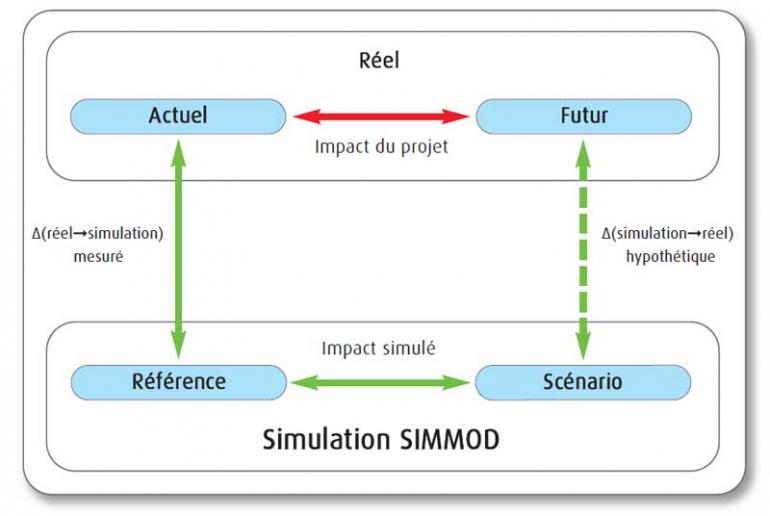Why the simulation?
Differences between analytical method and simulation method
An airport’s capacity can be determined in two radically different ways: analytically, by deducing the capacity directly from the characteristics of an airport and the traffic it takes, or less theoretically, by simulating the traffic flow on a model of the studied airport infrastructure and then by measuring the simulated flows.
The analytical method is therefore to understand capacity as a function of the characteristics of the infrastructure of an airport and the traffic it has to take. Thus, this method assumes that there is a more or less complex relationship directly linking all the characteristics of an airport (the layout of the runway (s) and taxiways, the structure of the traffic, the air traffic management methods, etc.) at the flow this airport can handle. The analytical method consists of approximating this theoretical relationship using a mathematical model that subsequently makes it possible to determine any airport’s capacity based on a reasonable number of input parameters describing the characteristics of the airport and its traffic.
The MACAO software (Airport Capacity Analysis Model), developed by the STAC together with the CETE Méditerranée in order to make the analytical capacity evaluations, implement a mathematical model enabling quick and effective determination of the capacity of the runway systems based on a number of parameters describing the runways, their feed lanes, the structure of the traffic and the air traffic constraints of the airport studied.
The mathematical model developed only concerns the capacity of the runways, the link between the overall flow that can be handled through the entire set of airport links and the characteristics of each link being much more difficult to approach with a mathematical model.
The simulation method, on the other hand, doesn’t try to deduce the capacity based on explanatory factors. It involves trying out the handling of a certain type of traffic on a certain infrastructure in a virtual rather than real way in order to obtain measurements of the flows that can be handled by an airport. The simulation method is therefore based on the use of a digital model that is closer to the way the traffic flows in an airport infrastructure and in airspace so as to be able to extrapolate the trends observed in real-world simulations.
The main difference between the analytical method and the simulation method is therefore that use of simulation does not require any knowledge of the relationship between the parameters studied and the capacity. It is thus possible to use the simulation method to assess the impact of parameters whose possible effect on the capacity is unknown, whilst the analytical method only allows us to act on parameters whose influence on the capacity we do know

Possibilities offered by use of simulation
Simulation has several major benefits compared to analytical calculation:
- The method offers better flexibility of use, the level of detail and the number of modelled links can vary.
- The level of detail is more refined. Indeed, while analytical calculation is limited to a macroscopic analysis of the capacity, simulation enables us to look at traffic conditions in a macroscopic manner as each aircraft modelled is simulated.
- The analysis is executed in time and space, it is possible to modulate use of the infrastructure and the structure and density of the traffic over time, and therefore to measure a capacity that is a function of time and space.
- This tool enables us to work on traffic management. It involves highlighting to what extent changes to procedures (traffic rules, aircraft de-icing rules, etc.) or “way of doing things” (management of runway crossings, sequencing of aircraft on take-off, etc.) contribute to the optimization of the traffic flow.
The simulation of a traffic flow can be used to assess not only the capacity but also the associated socio-economic aspects. Thus the speed and acceleration data of the simulated aircraft can be used, for example, to estimate their energy consumption and associated contaminant emissions.


Principle of a capacity simulation study
Modeling principles
The diagram of a simulation capacity study corresponds with the illustration below. This does not involve a direct comparison of the current real situation with the virtual trial results represented by the simulations of a study scenario.
We cannot compare an actually observed situation with a simulated future situation. The first stage involves comparing the actually observed situation with its simulated equivalent, enabling us to both confirm the model and quantify the bias between reality and simulation. It is thus useful to compare the simulated real situation with the simulated future situation.
The difficulty lies in estimating the difference between the simulated future and the future that would be observed if it happened.
This thus enables us to evaluate the real impact (the red arrow in the below illustration) using simulations (the three green arrows).

Updated on Nov 25 2022
